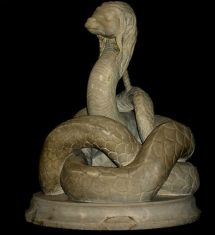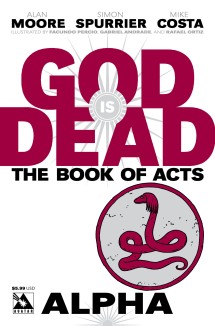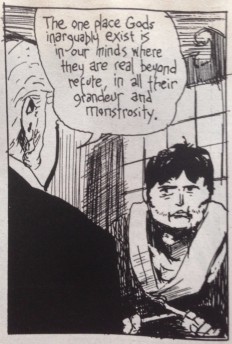God Is Dead: Book of Acts, Alpha
Below are annotations for God Is Dead: The Book of Acts, Alpha “Grandeur and Monstrosity” (10 pages, July 2014)
Writer: Alan Moore, Artist: Facundo Percio
>Go to Moore God Is Dead annotations index
Note: some of this stuff is obvious, but you never know who’s reading this and what their exposure is to any given reference. If there’s stuff I missed or got wrong, let me know in comments, or email linton.joe [at] gmail.com
General:
- The story tells the return of the snake-puppet god Glycon – somewhat analogous to other gods returning in earlier God Is Dead stories. Writer Alan Moore appears on on-stage with Glycon.
Cover
- The snake on the cover is Glycon – see P6,p2 below.
Page 1
panel 1
- “The Gods were back” is a description of the plotline of the God Is Dead series – see Wikipedia for full plot synopsis.
- The door (here through P3) is Moore’s own front door in Northampton, England – see Instagram image.
- Panels 1 through 5 are a zoom sequence. They depict the same scene as the “camera” moves closer. AM uses these sequences now and then, including famously on P1 of Watchmen.
panel 2
- Note the snake motifs on the door and the green circular elements on the posts.
panel 4
- Panel 4-5, and the following P2,p2-P3,p1 form an alternating fixed-camera sequence.
panel 5
- The eyes belong to the story’s author Alan Moore.
Page 2
panel 1
- The door resembles Moore’s own front door in Northampton, England – see Instagram image.
- The story’s title references Moore’s own From Hell. On Chapter 4, Page 18, panel 3, William Gull states “The one place Gods inarguably exist is in our minds where they are real beyond refute, in all their grandeur and monstrosity.”
Moore cites that writing this panel spurred his interest in magic. From a 2001 interview at Comic Book Resources: (thanks Alexx Kay)
The thing that turned me towards magic was a panel in From Hell where William Gull was saying something to the effect that the human mind is one place where all of the gods and monsters in human mythology are arguably real, in all of their grandeur and monstrosity. And after writing I thought, oh shit, that’s true. Now I am going to have to rearrange my entire life around this. There is no way to disprove it. I thought I was writing this great piece of Gothic villain dialogue. The gods and monsters inarguably exist and they are real. Because if they don’t exist how many people died because of them, or how many history changing things have been done in the name of these Gods that don’t exist? If they don’t exist why do they kill so many of us in their name? So at that point, it was just before my 40th birthday. I thought, well I could have a mid-life crisis and just bore everybody to death by going on about, what’s it all about, what does it all mean? Or I could sort of just go spectacularly mad, which would at least be more entertaining for those around me. And more worrying. And that’s good as well. Because I’ve started to run out of ways of worrying people. You should have seen the look on their faces when I said, I think I’ll become a magician. Half of them were frightened because they thought id probably gone mad, and the other half were frightened in case I hadn’t.
It seems to me that much of science doesn’t like to even accept that there is anything going on inside our heads and wants to base it all upon hard proven laboratory things. But the mind is the only thing that we have any direct experience of. We don’t perceive the world directly. We perceive our perception. We put together these weird jigsaw puzzles made from the light on our retina, the sound waves in our eardrums, the texture of our fingers. And moment by moment we are kind of compositing this together on some big screen that is reality. That is what we see. If we have a flaw in any of our perceptual systems than that will become part of our reality. I suppose magic was an attempt to kind of see if I could take my relationship with reality any further into any different areas.
panel 3
- There is a clever playful self-consciousness that permeates the story. The first example is this line “between writing the last caption and this one.”
Page 3
panel 2
- “Mitch” is Mitch Jenkins, a photographer and filmmaker whom Moore has collaborated with, for example.
- Panels 2-7 are a fixed-camera sequence.
panel 5
- “The O2” is a large scale London concert venue formerly known as the Millenium Dome. Perhaps somewhat cheekily (or possibly an error likely introduced by the letterer) Moore refers to it as the O2 (O squared) instead of as the O2 (double-Oxygen molecule – what humans breathe.)
- “It’s not even real. It’s just in a comic.” is more of the playful self-consciousness mentioned in P2,p3 above.
Page 4
panel 2
- “A few were even admirers of the reluctant high priest’s own work. The early stuff obviously.” refers to us comic book fans who enjoyed Moore’s early superhero comics. The two people on the right are comic fans. The first is wearing a Shazam (yellow lightning bolt on red field) shirt, referring to Moore’s Miracleman comics. The second wears a cap with a Batman logo, referring to Moore’s The Killing Joke.
Page 5
panel 1
- “The show started slightly later than advertised” could allude to many of Moore’s comics publishing after their projected dates.
panel 2
- The “Norse Giantess” is Angrboða.
- The “Midgard Serpent” is Jörmungandr.
- “Fenris Wolf” is Fenrir, a monster-wolf from Norse Mythology.
Page 6
panel 1
- Moore’s shirt reads “Miskatonic University” which is a fictional college from the works of H.P. Lovecraft. Moore later portrayed Miskatonic University in Providence No.5-6.

Ancient marble statue of Glycon. Photo by ChristianChirita via Wikipedia
panel 2
- Glycon is an actual historic snake god dating back to the ancient Greeks. Moore has discussed his personal experience seeing and relating to Glycon:
In my own experience – and this is where we get into the complete madness here – I have only met about four gods, a couple of other classes of entity as well. I’m quite prepared to admit this might have been a hallucination. On most of the instances, I was on hallucinogenic drugs. That’s the logical explanation – that it was a hallucinatory experience. I can only talk about my subjective experience, however, and the fact that having some experience of hallucinations over the last twenty-five years or so, I’d have to say that it seemed to me to be a different class of hallucination. It seemed to me to be outside of me. It seemed to be real. It is a terrifying experience, and a wonderful one, all at once. It is everything you’d imagine it to be. As a result of this, there is one particular entity I feel a particular affinity with. There is a late Roman snake god, called Glycon. He was an invention of the False Prophet Alexander. […]
Anyway, the false prophet Alexander is a Moon and Serpent hero, a saint if you like. He was running what seemed to be a travelling Seleni medicine show. He would do a performance of the mysteries of the goddess Soi. The only reference to him is in the works of Lucian, who calls him a complete charlatan and fraud. At some point, Alexander the False Prophet said he was going to preside over the second coming of the god Aeschepylus [or Asclepius], the serpent god of medicine. He said this is going to happen at noon tomorrow in the marketplace. So everyone said, “sounds good,” and they all went down there. After a little while, they said, “Come on, False Prophet Alexander, where is the second coming of Aeschepylus?” At which point, the False Prophet Alexander bent down, reached into a puddle at his feet, pulled up an egg, split it with his thumbnail, and there was a tiny snake inside, and said, “Behold the new Aeschepylus,” took it home with him, where over a week it apparently grew to a prodigious size until it was taller than a man and had the head and features of a man. It had long blonde hair, ears, eyelids, a nose. At this point, he started to exhibit it in his temple, providing religious meeting with this incarnate god. At which point, Lucian said, it was obvious, “I could have done that.” […] He got the snake’s head under his arm, speaking tube over his shoulder, child’s play. And he’s probably right, that’s probably how he did it.
If I’m going to adopt a god, I’d rather know starting out that it was a glove puppet. To me it’s a real god. There’s nothing that precludes a glove puppet from being a real god. […] But a god is the idea of a god. The idea of a god is a god. The idea of Glycon is Glycon. If I can enhance that idea with an anaconda and a speaking tube, fair enough. I am unlikely to start believing that this glove puppet created the universe. It’s a fiction. All gods are fiction. It’s just that I happen to think that fiction’s real. Or that it has its own reality that is just as valid as ours. I happen to believe that most of the important things in the material world start out as fiction. That everything around us was once fiction – before there was the table, there was the idea of a table, and the idea of a table before tables was fiction. This is the most important world, the world of fictional things. That’s the world where all this starts. (from Alan Moore: Conversations, page 85-86, 1998 interview with Matthew De Abaitua)
- For more reading about Moore and Glycon, see these articles: (Thanks Flavio Pessanha of Alan Moore BR)
– The Serpent and the Sword, by Alan Moore, Tales of Midnight, October 1999
– Snake or Fake? The true story of Alan Moore’s favourite deity, by Steve Moore, Fortean Times, June 2011
Page 7
panels 1,3-4
- These form a fixed-camera sequence.
panel 4
- Moore drinks a glass of water, a staple of ventriloquist performances.
Page 8
panels 1-5
- These form a zoom sequence. Moore uses zoom sequences frequently, including on P1 of Watchmen #1. In panel 5, it is ambiguous whether the puppet’s head has shifted, or the reader’s perspective has shifted.
panel 1
- “Here Comes Honey Boo-Boo” (actually just “Boo Boo” with no hyphen) is an inane reality TV show that ran from 2012-2014. See for yourself.
panel 4
- Glycon as “the last-created Roman diety” is a point that Moore makes about the historical Glycon – see P6,p2 above.
Page 9
panels 2, 5-6
- These form a fixed-camera sequence.
Page 10
panel 1
- Panels 1 and 5 form a zoom sequence, which effectively starts on P9,p6. The frame is moving closer to the subject. It may be unintentional, but the snake-puppet appears to have moved slightly; note the tongue and the position relative to the microphone stand. In the upper panel, Glycon is contained: located entirely within the panel borders, and behind the mic stand. In the lower panel Glycon is in front of the mic stand and its hair and tongue extend beyond the borders.
- Panelwise, the page alternates between light and dark panels.
panel 2
- “Fell upon the multitude” is biblical language.
- “Saving only a few” has a clever double meaning. On the surface, the caption describes that a few members of the crowd were not silent. “Saving” can also be read with its religious meaning: “save” as salvation (as in “Jesus saves.”) Hence it also means that Moore’s performance ‘saved’ (converted?) only a few attendees.
panel 3
- “Later material [left people] with a sense of disappointment” is a self-deprecating poke at Moore’s later work not always appealing to a broader audience who seek more of his early superhero work.
- The passenger is reading a Daily Scream newspaper, with the headline “[SOME?] GUY [S]AYS [SOM]ETHING” reiterating the point that the “speech… was not widely reported.”
- The “regional British accent” is, of course, Moore’s very recognizable Northampton accent.
- Panels 3 and 4 form a zoom sequence (or perhaps a fixed-camera sequence – as the camera is perhaps holding still while the subway car moves away.) This object appearing smaller contrasts with panels 1 and 5 where the puppet appears larger.
panel 5
- There is a (perhaps obvious) double meaning in the “[concepts] that work us. That supply our every word.” This applies to broader ideas – “economics, politics, religion” – working the “vast populations.” It also applies to Moore supplying every word of the Glycon puppet.
- “Steve Moore” was a comics writer, credited with bringing Alan Moore (no relation) into the profession. Steve Moore was one of Alan Moore’s best friends, and his companion in the magical explorations that led Alan Moore to Glycon-worship. (Steve himself was a Selene worshiper, as recounted in Alan Moore’s Unearthing.)
>Go to Moore God Is Dead annotations index


27 October 2016 at 12:26pm |
Good stuff. This is a really fun story for anyone who has enjoyed reading about Moore’s interpretation of Glycon in interviews over the years (which you have woven into these annotations).
Glycon may only have one actual follower in these modern times, but what a follower haha!
I hadn’t caught the title being from that great line in From Hell. Totally makes sense.
“The early stuff obviously” line really made me laugh.
5 March 2017 at 6:41pm |
The O2 is named after the mobile phone company, who paid a lot of money and either own it, or paid to name it. Technically in their advertising they use subscript 2, as in oxygen. But don’t go thinking London gave one of it’s buildings an interesting name, with lots of meaning. It’s just a big mobile phone advert.
29 July 2019 at 11:04am |
[…] snake is a cobra standing in for Moore’s snake-puppet diety Glycon – which would be a sock-puppet snake with […]